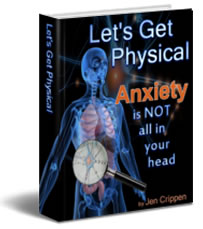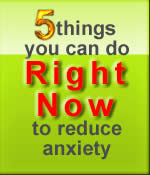Anxiety Therapy the OrthoMolecular Way
People often ask how I got better and where I get my information from. Most of my information came from 10 years of practice, seminars, books, and my biggest teacher … personal experience! There wasn’t a workshop that could’ve prepared me for when I got sick in 2007. I was a supposed “expert” on natural health and I was the one who was knocked on my butt from sickness! When people come to me know asking for places to learn more about my position on health, I encourage them to learn more about Functional Medicine & OrthoMolecular Psychiatric Medicine for panic and anxiety therapy.
OrthoMolecular Psychiatric Medicine is part of Functional Medicine, this post I am focusing on OrthoMolecular. The next post will focus on Functional. Medical Doctors, Osteopathic Doctors, Chiropractic Doctors, and some Naturopathic Doctors are the professionals who are trained in this philosophy. I adore the medical and chiropractic doctors in my life who have helped me by practicing this way: Ann Stanger MD, Joel Lopez MD, William Hobbins MD, Chris Danduran DC, Michale Buskohl DC, and Diana Sabella DC.
Orthomolecular Psychiatric Medicine is not like aliopathic, it doesn’t just treat symptoms. It treats causes. When I was sick, I knew that if I took drugs I would only be masking a symptoms. Sure Xanax, Wellbutrin, Prozac and other medications of the like would help me feel better – superficially. They did not fix the reason why I had anxiety, adrenal fatigue, blood sugar imbalances, food allergies, and panic attacks. There was an ENORMOUS underlying issue – imbalance and deficiency.
This is a great definition from International Society for Orthomolecular Medicine website: “Orthomolecular medicine, as conceptualized by double-Nobel laureate Linus Pauling, aims to restore the optimum environment of the body by correcting imbalances or deficiencies based on individual biochemistry, using substances natural to the body such as vitamins, minerals, amino acids, trace elements and fatty acids. The term “orthomolecular” was first used by Linus Pauling in a paper he wrote in the journal Science in 1968. The key idea in orthomolecular medicine is that genetic factors affect not only the physical characteristics of individuals, but also to their biochemical milieu. Biochemical pathways of the body have significant genetic variability and diseases such as atherosclerosis, cancer, schizophrenia or depression are associated with specific biochemical abnormalities which are causal or contributing factors of the illness.”
You can also find more information from OrthoMolecular.org, OHM Society, and Linus Pauling Institute. My Let’s Get Physical: Anxiety is NOT All In Your Head ebook was written based on my journey of helplessly ill to recovery using OrthoMolecular principles.  It is the step by step process of what worked that lead me to getting better, I left out all the stuff that didn’t work!
It is the step by step process of what worked that lead me to getting better, I left out all the stuff that didn’t work!
Anxiety Therapy by Getting Rid of Food Allergies
 I apologize there’s been a lapse in time in posts. Between moving in August and getting notice I have to finish my Masters Degree by January, getting to the computer has been a bit challenging. Thank you for your patience! This post is a bit brainy, it is a write up I had to do for my schoolwork. It explains what happens chemically in your body when you have a reaction to a food. I felt is was important to share with you because eliminating food allergies was a huge part of my anxiety therapy.
I apologize there’s been a lapse in time in posts. Between moving in August and getting notice I have to finish my Masters Degree by January, getting to the computer has been a bit challenging. Thank you for your patience! This post is a bit brainy, it is a write up I had to do for my schoolwork. It explains what happens chemically in your body when you have a reaction to a food. I felt is was important to share with you because eliminating food allergies was a huge part of my anxiety therapy.
The body responds to food sensitivity by releasing antibodies in response to signals from foreign substances coming from the immune system. The antibody is immunoglobulin G (IgG) and is only found in the bloodstream. When IgG is released and meets a macromolecule, the entire immune response is kicked off. Histamines and other chemicals are released and the area is flooded with extra fluid as a way to wash away the reactive food particles.
At the same time the body produces hormones (including cortisol and aldosterone) which increase sodium intake, which attract more water into cells and tissues. Other hormones are released by the gut that causes water retention in the gut tissues (BLOAT!).
The production of histamine and other chemicals cause blood vessels to expand and contract, leaking fluids into the tissues and setting off a secondary inflammatory response and swelling. This leaking fluid often carries protein with it and the protein attracts sodium and still more fluid.
To compound the weight gain from waterlogged tissues, food sensitivities also trigger weight gain from adipose tissues. This results from either heightened cravings for reactive foods or the disruption of metabolism.
The same response that is responsible for the bloating also sends out distress chemicals via natural chemicals and hormones. First, endorphins hit the system which make you feel good. Then, when they wear off, BAM … cravings strike. Second, the adrenals release epinephrine, norepinephrine, and cortisol that result in a mood lift. When these wear off, irritability and fatigue set in. Once again, cravings strike. Third, insulin levels become destabilized which lowers blood sugar levels; cells are starved for energy. These first three responses create overload on the adrenals; hence, adrenal fatigue. The surge of neurochemicals and hormones also can create anxiety and mood swings.
Finally, the levels of “feel good” neurotransmitter serotonin drops. When the immune system goes into high gear due to a food sensitivity reaction, the white blood cells are too busy fighting the invasion to carry serotonin. The cravings for high carbohydrate foods help the body replenish serotonin in the brain. These chemical reactions and hormone disruptions allow pounds to come on very easily. Metabolism is slowed within epinephrine (adrenalin) levels are depleted causing increased fat storage. Or, the thyroid doesn’t function properly due to the signal hormones are imbalanced. Thyroid gland is a key component for the body’s fat burning process.
Insulin Resistance Approved: Blueberry & Apple Cobbler Recipe – OMGosh
Oh my, this one is for the record. I’m even getting hungry thinking about this cobbler because it is so good. Plus, it’s super duper simple to make! As always, the ingredients have been chosen to keep our blood sugar balanced and not create insulin resistance.
Blueberries are famous anti-oxidants, they help protect the body against free radical damage. They protect your brain (anxiety therapy!), eyes, heart, and colon. Blueberries are also high in manganese which helps us combat stress and fight anxiety / panic. Plus, they taste so delicious!
I love apples because the are low glycemic like blueberries (won’t spike blood sugar) and they are high in soluble and insoluble fiber. This in turn helps balance our blood sugar levels and takes stress off of our adrenals.
Coconut oil, well … it’s just awesome!!! Coconut oil has a rich taste but it also helps balance blood sugar levels, combats candida (yeast overgrowth), and regulates the thyroid. It’s like putting a long, slow burning log in the fire and gives us high quality fuel to burn.
I love almonds, they are a great source for tryptophan. Tryptophan is what turns into serotonin in our body, which is the “feel good euphoric” brain chemical. Most of us who have experienced depression, anxiety, panic, or sleep problems are often low in serotonin.
Then there are the YLTG (Young Living Therapeutic Grade) oils. These aren’t the kind you find in health food or grocery stores. These are true medicinal grade and can be eaten SAFELY. Commercially found stuff cannot and should not be ingested! Besides tasting great, they offer health benefits. Cassia increases insulin receptor sensitivity. Clove is one of the highest anti-oxidant substances known on earth. Onycha is anti-inflammatory and soothing. You can find them at http://www.anxietytherapyremedies.com or contact me at Jen@NaturalAnxietyTherapy.com. The onycha and cassia are only found in the 12 Oils of Ancient Scripture Kit.
Blueberry Apple Cobbler Recipe
Preheat oven to 400 degrees.
Ingredients:
Topping:
½ pound or 8 ounces of salted roasted almonds
¼ cup of coconut flour – sifted.
¼ cup ground flax (freshly ground is the best)
1 tsp salt
½ cup coconut oil or butter – melted (warm, not hot)
1 egg
1 drop YLTG cassia
1 drop YLTG onycha
Partial drop of YLTG clove oil
½ c. of Grade B Maple Syrup (two ¼ cups: one for dry mixture and one for drizzle)
Fruit Mixture:
3 small golden delicious apples
2 c. fresh blueberries (1 pint)
½ lemon
Instructions:
Core apples and slice them into eighths. Then chop slices into smaller bite sized pieces. Put into a 8 X 8 X 3 inch baking dish along with the pint of blueberries. Squeeze the juice of the lemon over the fruit. Set aside
To prepare the almonds, finely grind half of them. The other half, chop in the processor so they are chunky small pieces. (The size of peanut chunks that are used to roll caramel apples in.)
Place all of the almonds in a medium sized bowl. Add the flax, coconut flour, and salt. Mix ingredients together and set aside.
In a small bowl, mix together the melted coconut oil (butter), egg, cassia, onycha, and ¼ cup of maple syrup. Mix with hand mixer until evenly blended. Add clove oil by using a toothpick to dab the top of the bottle, stir this into the liquid mixture. One whole drop is overkill!
Make a well in the dry mixture of nuts, flax, and coconut flour. Pour in the liquid mixture and stir enough so the dry mixture is completely wet. Do not over mix. Sprinkle it over the top of the blueberries and apples so it’s evenly distributed. Then drizzle the remaining ¼ cup of maple syrup over the top right before putting it in the oven.
Bake for 30 to 40 minutes, until the blueberries are bubbling up through the topping and top is golden brown.
THEN ENJOY!!!!
Insulin Resistance Recipe: Now THAT’S a Tuna Salad!
I love tuna salad, but not your momma’s version with mayo, onions, and celery. My recipe is chock full of veggies that will nourish your body, balance your blood sugar, and help heal your insulin resistance.
You may have heard, tuna can have mercury in it and should be eaten twice a week MAX. I only eat tuna once or twice a month, just my pre-caution (See the EPA’s INFO). But, I do have a strategy with my recipe design – surprised? I add a BUNCH (no pun intended!) of cilantro. Cilantro is known the chelate (take out) mercury from the central nervous system. Tomatoes being high in Vitamin C helps get the mercury OUT of the body. The vitamin E in the olive oil helps protect your brain too! Ahhhh, foods are always the best medicine.
“Now THAT’S a Tuna Salad” Recipe
Ingredients:
1 cucumber
¼ onion or 3 scallions
1 medium tomato
2 cans of tuna
1 bunch of cilantro
4 stalks of celery
2 tblsp olive oil
1/3 cup Latin Lemonaise (from The Ojai Cook)
Salt and pepper
Instructions:
Chop up cucumber, tomato, celery, cilantro, and onion (scallion) and add to a bowl. Flake apart tuna and add to vegetables. Dress with olive oil and mayo. Mix all together so dressings are evenly distributed. Salt and pepper to taste.
* Latin Lemonaise is readily available in local grocery stores, often found in the health food section. If you do not have access to this brand, zip up regular mayo or Vegenaise with chili, jalapeños, cumin, garlic, mustard, cayenne, and some freshly squeezed lemons and lime.
Anxiety therapy comes best when it’s comes in the form of great food!










